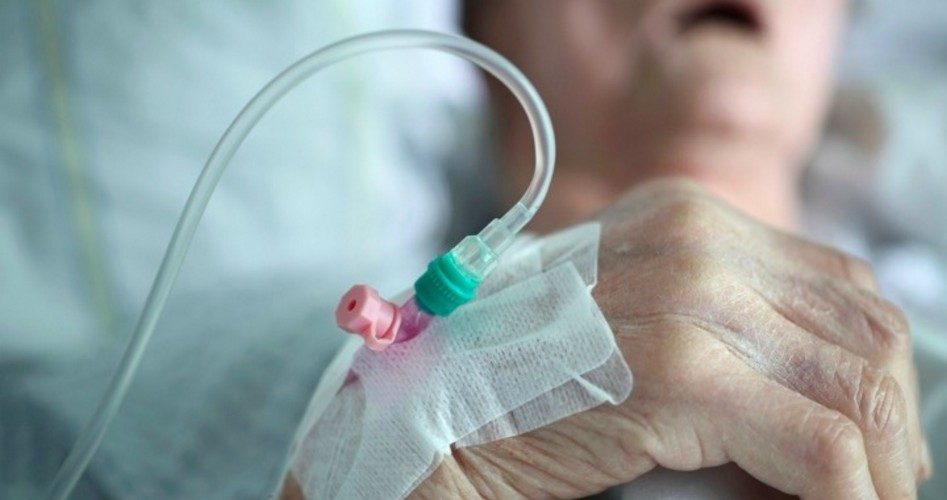
The British National Health Service (NHS) — the epitome of socialized medicine — may be prematurely ending the lives of as many as 130,000 elderly patients annually, a top physician told the Royal Society of Medicine in London. Patrick Pullicino, a consultant neurologist for East Kent Hospitals and professor of clinical neurosciences at the University of Kent, said a controversial end-of-life care method called the Liverpool Care Pathway (LCP) now used in British hospitals has become an “assisted death pathway rather than a care pathway,” according to a report in the Daily Mail.
“If we accept the Liverpool Care Pathway we accept that euthanasia is part of the standard way of dying as it is now associated with 29 per cent of NHS deaths,” Pullicino declared, referring to statistics showing that of the 450,000 annual deaths of patients under NHS care, about 130,000 are of patients who were on the LCP.
The Mail offers a brief history of the LCP:
The Liverpool Care Pathway was first developed at a Marie Curie [Cancer Care] hospice in the city with the intention of making the last days and hours of cancer sufferers as decent and painless as possible.
It rapidly became fashionable: recognized as a model for the NHS in 2001; approved by NICE [the National Institute for Health and Clinical Excellence, which rations care on a cost-benefit basis] as a recommended practice in 2004; and a 2006 health white paper said it should be adopted across the country. Its use spread from cancer sufferers to all patients. Doctors are supposed to identify a patient who is bound to die in the near future.
The plan then can include withdrawal of treatment, including the provision of water and nourishment by tube. Patients are typically heavily sedated.
The LCP’s quick adoption by the NHS and NICE represented “euthanasia by the back door,” in the words of the Telegraph’s Gerald Warner. “In 2007–08,” he wrote, “16.5 percent of deaths in Britain resulted from continuous deep sedation — twice the rate of the Netherlands with its notorious culture of death and legalized euthanasia.”
Since that time the percentage of deaths due to the LCP has increased by 75 percent, with no signs of slowing. Indeed, with the NHS “heading for an iceberg” (as NHS Confederation chief executive Mike Farrar put it) of unsustainable costs, the LCP death percentage is likely to grow even more rapidly. It costs far less, after all, to give a patient morphine for a day or two — death occurs on average within 33 hours of beginning the LCP — than to treat his condition for the remainder of his natural life, which could last for months or even years. Pullicino, according to the Mail, recalled taking a 71-year-old patient off the LCP, after which the man lived another 14 months, mostly at home, “at considerable cost to the NHS and the taxpayer.” (He died after being admitted to the hospital for pneumonia and put back on the LCP.)
Other doctors have recounted similar experiences. Dr. Peter Hargreaves, a consultant in palliative medicine at St. Luke’s Cancer Center in Guildford, told the Telegraph in 2009 that “he had personally taken patients off the pathway who went on to live for ‘significant’ amounts of time.”
Hargreaves worried that the LCP could “become a self-fulfilling prophecy” because doctors would make the determination as to which patients were likely to die and then, by withdrawing lifesaving treatment and heavily sedating them, guarantee that they would die. As Hargreaves and other experts put it in a letter to the Telegraph, “Forecasting death in an inexact science,” and “sometimes, when all but essential drugs are stopped, ‘dying’ patients get better.”
In fact, Hargreaves noted, some patients may exhibit signs of dying when their bodies are merely reacting to sedation combined with dehydration and then “be wrongly put on the pathway.” Once a patient is sedated under the LCP, University of London geriatrics professor P.H. Millard told the Telegraph, “it is much harder to see that a patient is getting better.”
Pullicino echoed many of these sentiments, saying that “patients are frequently put on the pathway without a proper analysis of their condition,” that “predicting death” at a specific time “is not possible scientifically,” and that, as a result, “very likely many patients who could live substantially longer are being killed by the LCP.”
He cited “pressure on beds” — which is to say the inevitable shortage of care under socialized medicine — and “difficulty with nursing confused or difficult-to-manage elderly patients” as reasons that the LCP has become so widely employed by the NHS. In other words, it’s much cheaper and easier to bump old people off than to treat them. Who’s going to know which ones might have recovered and enjoyed a few more years with their children and grandchildren?
No one should be surprised that government-run healthcare kills people. All socialist systems end up rationing whatever goods and services they have to offer; and when you’re rationing healthcare, the most vulnerable patients are going to suffer the most. The only surprising thing is that there are still people who think socialized medicine is a dandy idea — among them President Barack Obama, who said multiple times that he wanted a “single-payer universal healthcare program”; his Secretary of State, who once tried to foist such a system on Americans; and his former Centers for Medicare and Medicaid Services director, Dr. Donald M. Berwick, who declared his undying love for the NHS. Who, then, could doubt that ObamaCare’s purpose is to put the American healthcare system on the LCP — and when the system finally keels over, to convert the United States to a single-payer system and the “death panels” that such a system invariably entails?


